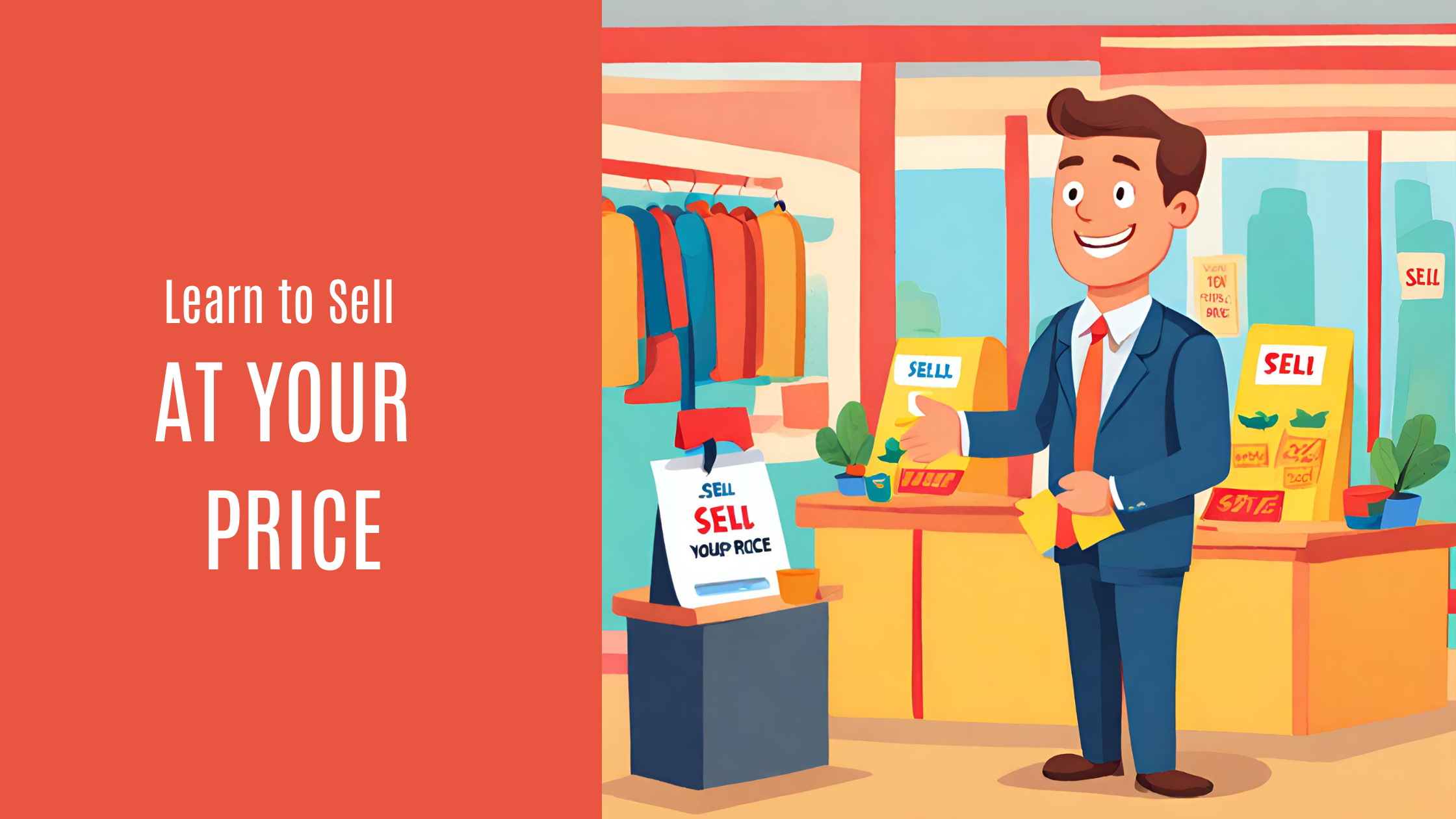Introduction:
In the ever-evolving landscape of business and commerce, one principle stands tall as a beacon of empowerment for entrepreneurs and sales professionals alike – the ability to “Sell at Your Price.” Gone are the days of rigid pricing structures and one-size-fits-all approaches. Today, successful selling is about embracing the power to set your terms, confidently navigating negotiations, and ensuring that the value you provide is rightfully compensated.
In this blog, let us embark on a journey into the realm of strategic pricing and the art of selling at a price that aligns with both the worth of your product or service and the expectations of your market. Whether you’re a seasoned entrepreneur looking to revamp your pricing strategy or a budding salesperson eager to master the delicate dance of negotiation, our exploration of “Sell at Your Price” promises insights, strategies, and actionable tips to help you command the value you deserve in the marketplace.
Are you ready to step into a world where your pricing decisions are driven by your expertise, the value you bring, and the unique proposition of your products or services? Let’s embark on this transformative journey together and learn how to “Sell at Your Price” with unwavering confidence and strategic finesse.

Strategies:
Create a Brand Persona:
Establish a unique identity for your brand within your category if you wish to sell at your price. Take inspiration from successful brands like Apple or Tesla, who have carved a distinct niche in their respective markets.
Focus on the quality of the product:
A high-quality product acts as a linchpin in determining pricing autonomy. It not only justifies a higher price but also establishes a sustainable foundation for long-term success in the market. By prioritizing quality, sellers can confidently set prices that reflect the true worth of their exceptional offerings.
Highlight the Value:
Emphasise the value your product or service brings to sell at your price. Showcase features that set you apart and solve the customer’s problems more effectively than competitors. By focusing on the product’s exceptional features and how they cater to the user’s needs, this approach shifts the emphasis away from price and instead invites the consumer to consider the value they would gain from choosing this smartphone. It allows the customer to envision the benefits and advantages, creating a narrative where the product’s worth is evident beyond the monetary aspect.
Learn Effective Selling:
A good salesman can sell ice to an Eskimo. Invest time in understanding and mastering the art of selling. Utilise proven sales techniques, build rapport with customers, and focus on building long-term relationships to sell at your price.
Leverage Testimonials:
Use customer testimonials as social proof. Positive feedback from satisfied customers can instil confidence in potential buyers. Positive testimonials serve as a form of word-of-mouth marketing. This can lead to organic growth, where satisfied customers recommend your product or service to others. Testimonials contribute to the overall perceived value of your product or service. When customers share positive experiences, it adds intangible value that goes beyond the physical attributes of the product. This heightened perceived value can justify a higher price and you can sell at your price.
Create the Right Ambience:
If selling physically, ensure that the ambience aligns with the perceived value of your product. A well-designed and upscale environment can positively influence buyer perceptions. Let us take an example of a five-star luxurious hotel. The higher cost of a five-star hotel is justified by the combination of plush ambience, exceptional service, luxurious accommodations, fine dining, world-class facilities, attention to detail, exclusive experiences, security and privacy, prime locations, brand reputation, and customization. Guests are willing to pay more for an elevated and memorable experience that goes beyond the basics.
Offer Customization:
Provide options for customization and personalization. Tailoring your product or service to individual needs can justify a higher price point. Imagine a guest booking a high-end suite in a five-star hotel for a special occasion, such as a honeymoon or anniversary. To justify the higher cost, the hotel employs a personalised approach by offering pre-communication that includes a questionnaire asking about specific preferences, dietary restrictions, any special occasions they are celebrating, and their favourite amenities or activities, customised room set-up, personalised dining experience, concierge assistance for special services, and offering personalised services.
Educate Your Customers:
Enlighten your customers about the unique aspects of your offering. Educating customers can position you as an expert in the industry and provide you with a reason to sell at your price. An informed customer is more likely to understand and appreciate the value, justifying the price.
Build a World-Class Service System:
Offer impeccable customer service. A reliable and efficient service system can enhance the perceived value of your product, justifying a higher price.
Be Convinced Yourself:
Confidence in your product or service is contagious. Believe in what you offer, and this conviction will resonate with potential buyers and you will be able to sell at your price. When you genuinely believe in the product, your enthusiasm and conviction come across as authentic. Customers can often sense when a salesperson is merely going through the motions or trying to meet a sales target. Authenticity builds trust, and customers are more likely to buy from someone who genuinely believes in what they are selling.
Highlight Problem-Solving Expertise:
Clearly articulate the problems your product or service addresses. Position yourself as an expert in solving these issues, reinforcing the value proposition. Once a customer starts looking at you as someone who is addressing their problem and has a solution to offer, you can sell at your price.
Know Your Competitors:
Understand your competitors and their Unique Selling Propositions (USPs). Knowing the market landscape enables you to position yourself strategically and justify your pricing.
Some more strategies to sell at your price:
Create a unique product:
A perfumery produces small batches of artisanal perfumes using rare and exotic ingredients. Each fragrance is handcrafted and comes in limited-edition, artistically designed bottles. The uniqueness of the scents, along with the exclusive packaging, justifies a premium price.
Blue-ocean strategy:
Blue Ocean Strategy encourages businesses to break away from traditional competition and find innovative ways to create new market spaces with uncontested demand. It’s about making the competition irrelevant by offering a unique value proposition that stands apart from existing industry norms. This exclusivity allows sellers to sell at their preferred price.
Sell something scarce:
Selling something scarce can provide a unique advantage to set and sell at your price. There are several ways scarcity can influence pricing strategies and create an environment where you have more control over the pricing. Scarcity often increases the perceived value of a product. When customers believe a product is rare or in limited supply, they may assign a higher value to it. This perceived value can justify a premium price.
Scarcity creates a demand-supply imbalance. Suppose the demand for a scarce product is high. In that case, you can set a higher price because customers may be willing to pay more to secure the limited quantity available. Scarcity also creates a sense of urgency and triggers the fear of missing out. If customers believe that the product may not be available in the future, they are more likely to make a purchase quickly and may be willing to pay a premium to secure it before it’s gone.
Sell something that is used by some famous personality:
Fans often feel a deep emotional connection to their favourite celebrities. Possessing an item that belonged to a celebrity allows fans to feel closer to the person they admire, and they may be willing to pay a premium for this connection.
Sell something which is perceived to be a high standard or luxury:
High-end automobile brands such as Rolls-Royce, Bentley, and Bugatti offer cars with exceptional craftsmanship, cutting-edge technology, and exclusive features. Buyers are willing to pay a premium for these luxury vehicles, often customized to their preferences. Luxury fashion brands like Chanel, Louis Vuitton, and Gucci are known for their high-quality materials, craftsmanship, and iconic designs. Consumers are willing to pay a significant premium for designer clothing, handbags, and accessories as a symbol of status and style.
Brands like Cartier, Rolex, and Tiffany & Co. produce high-end jewellery and watches. These items are often made with precious metals and gemstones, featuring intricate designs and exceptional craftsmanship. People pay a premium for the prestige associated with these luxury brands. High-end real estate in prime locations with luxurious amenities and stunning architecture commands premium prices. Buyers invest in luxury properties for the lifestyle, privacy, and status they offer.
Conclusion:
Setting your price in a competitive market requires a combination of strategic thinking, effective communication, and a deep understanding of your product’s value. By creating a unique brand persona, emphasizing value, and employing effective selling techniques, you can confidently sell at your price. Remember, the key lies in convincing both yourself and your customers that what you offer is worth every penny.


Leave a Comment